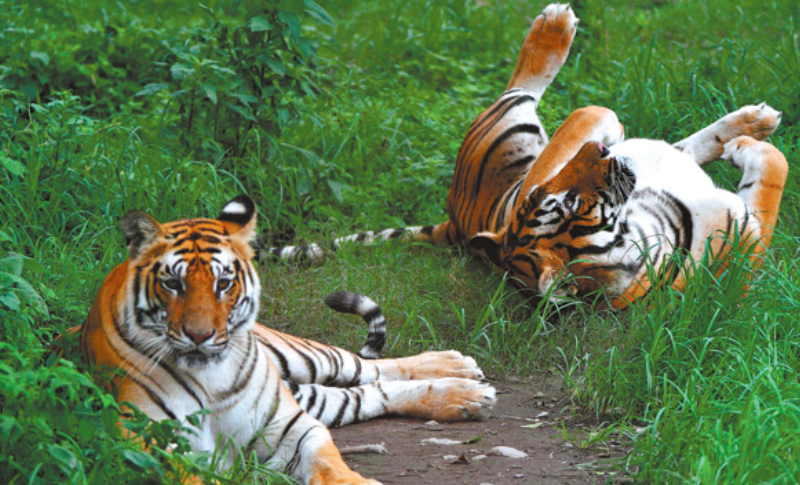Tiger population rises, conflicts drop in Nepal


Nepal's tiger population has risen and the frequency of fatal human-tiger conflicts has declined over the past decade. The country now aims for the sustainable coexistence of big cats and human beings. Wildlife conservationists claim Nepal can sustain up to 500 tigers based on available habitat, prey species and landscape management.
"Nepal's protected areas, buffer zones and forest corridors are now in a position to accommodate around 500 tigers. The availability of prey, improved grassland management and overall conservation efforts make this target feasible," said Hem Sagar Baral, country representative at the Zoological Society of London, Nepal Office.
Nepal had just 121 tigers in 2010. By 2022, that number had surged to 355, a remarkable achievement given the global decline in tiger habitats and populations. Over the past century, tiger habitats and populations have plummeted worldwide, leaving the conservation authorities struggling to increase the tiger population.
Experts attribute the population increase to effective anti-poaching measures, habitat restoration, prey population recovery, expansion of national parks and the establishment of wildlife corridors with India.
The Chitwan National Park, the country's oldest protected area, is home to the highest number of tigers in the country at 128, followed by Bardiya with 125. Likewise, Parsa houses 41, Shuklaphanta 36 and Banke 25.
Haribhadra Acharya, a senior ecologist at the Department of National Parks and Wildlife Conservation, emphasized that the country's core national park areas can support around 400 tigers, while surrounding forests can accommodate another 100.
"The increase in tiger numbers does not necessarily lead to more human-tiger conflict," said Acharya. "In fact, deaths from tiger attacks have decreased over the past three years," he added.
According to data from the National Trust for Nature Conservation, 75 people have died from tiger attacks in the past seven years. However, the annual death toll has fluctuated. In fiscal year 2021-22, there were 21 deaths, which dropped to 12 in 2022-23, 10 in 2023-24 and seven in the last fiscal year of 2024-25.
While the rise in tiger numbers is a conservation triumph, it also offers new economic prospects for the country. "We now need to capitalize on this success by promoting wildlife tourism," said Naresh Subedi, a member secretary at the National Trust for Nature Conservation.
"Tigers attract high-spending tourists. By offering opportunities to see them, we can help both conservation and local economies."
At the same time, the increase in tiger density is altering traditional behavioral patterns. Generally, a male tiger marks its territory over 50 square kilometers while a female marks the territory of about 30 sq km.
"In Bardiya, the average home range of a tiger has shrunken to just 7 to 8 sq km, compared to the norm of 30 to 50 sq km," said Ashok Ram, warden of Bardiya National Park.
This compression has led to overlapping territories and occasional infighting among tigers. "When young males lose territorial fights, they are forced to move toward the park's fringes, often ending up in human settlements and preying on livestock. Such incidents usually involve older, injured or weak tigers," said Ram.
A female tiger generally gives birth to two to four cubs, sometimes even seven. These cubs stay with their mother for up to three years before moving out to establish their own territories. Male cubs often end up in conflict with their fathers while trying to establish dominance. This natural dispersion process sometimes pushes tigers near human settlements.
To mitigate human-wildlife conflict, conservationists stress the need for better habitat management. "We must develop good habitats with patches of open grasslands for prey and dense cover for stalking," said Babu Ram Lamichhane, a tiger expert. "Proper habitat zoning in and outside national parks can ensure that tigers remain within their natural range."
Bringing benefits
Despite challenges, Nepal has emerged as a global leader in tiger conservation. The species is not only a symbol of power in Nepali culture but also a key ecological indicator. As apex predators, tigers help regulate herbivore populations, maintaining ecological balance and preventing the spread of disease.
"The real challenge now is showing the world that humans and tigers can live side-by-side," said Baral. "If we succeed, it will be a global conservation milestone."
As Nepal celebrates its success in expanding its tiger population and reducing human-tiger conflict, data from Chitwan shows how once-troubled areas like Kumroj are witnessing fewer deadly encounters with the big cats.
The fiscal year of 2021-22 saw 14 deaths from tiger attacks in Chitwan, with six incidents in the Kumroj buffer zone community forest area alone, four of them fatal. Since then, tiger attacks have declined. Just one person from the Kumroj area died from a tiger attack in the fiscal year of 2024-25.
Lamichhane, who has researched human-leopard and tiger interactions, believes that while tiger numbers are rising, there are not necessarily more attacks. "Tigers relocate to new forests as populations grow. Conflict arises when locals, unaware of their presence, enter these areas for firewood or forage," he explained.
"Just around 5 percent of all tigers may pose a threat to humans. Their timely capture can prevent casualties," Lamichhane suggested. Yet, managing rescued tigers is an ongoing problem. On July 23, Chitwan National Park captured a tiger near Meghauli village. Although it had not harmed anyone, its proximity to human settlements made intervention necessary.
With limited enclosures, tigers are often kept in inadequate facilities. "We currently house seven tigers, but space and resources are tight," said Abinash Thapa Magar, information officer at the Chitwan National Park.
Conservationists underscore the need for building a spacious area. "We need spacious, zoo-style habitats to house rescued tigers safely and boost eco-tourism — a step crucial for sustaining both conservation and community support," said Ganesh Pant, chief conservation officer of Chitwan National Park.
THE KATHMANDU POST, NEPAL































